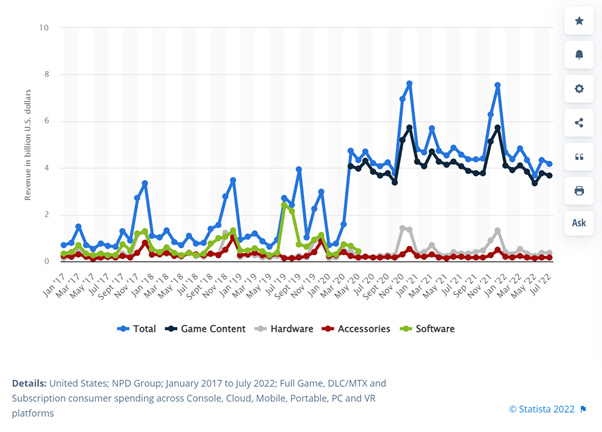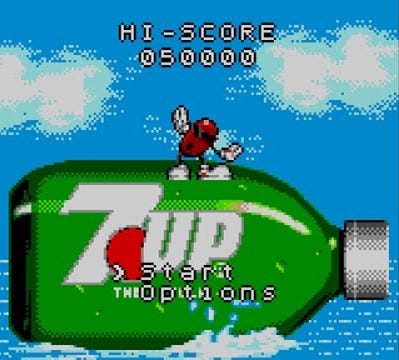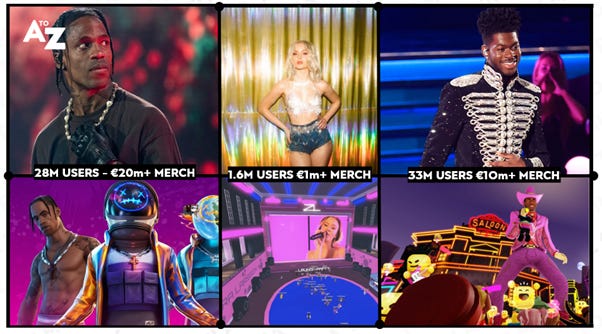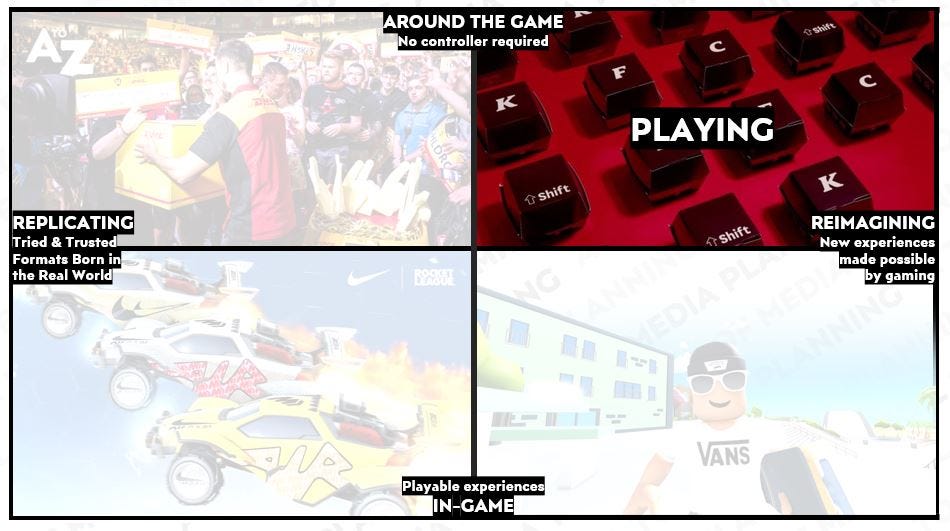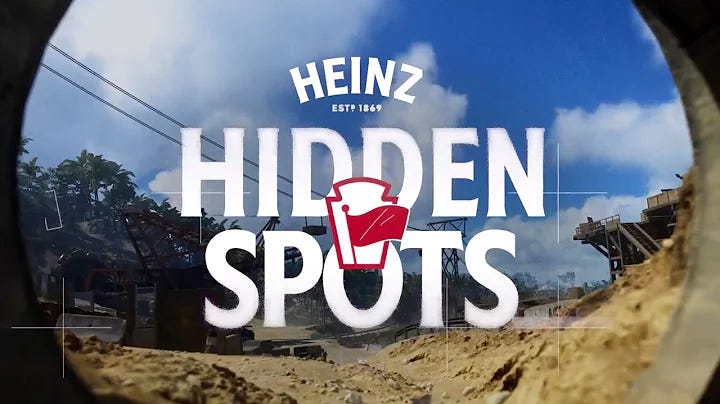J is for... Joysticks
Five ways brands are unlocking the cultural and commercial potential of gaming
When thinking about what to write for J there weren’t that many obvious candidates.
It is an 8 point scrabble word after all.
A light went on though when I was presenting to a bunch of clients a couple of weeks ago.
My presentation was about The Metaverse but taking stock 18 months on, starting with a healthy dose of realism but emphasising some of the most exciting opportunity spaces made possible by gaming.
In that deck was a picture of a massive Joystick from the Arcade era which got some reactions from some colleagues on the ZOOM call, which made up my mind about what to write about for J, that just so happened to be a much more attractive option than some of the alternatives such as Consumer Journeys (I covered that a little in Contexts) or JPEGs burned onto the blockchain.
Hence for this post J is for… Joysticks
Where I’ll share the size and the shape of the opportunity in gaming for you to use as starting points, reference points and evidence points for any work you’re about to do, or wish to convince your clients or colleagues to do in this space.
Pulled apart via a simple framework you may wish to steal, re-apply or re-mix.
Illustrated with some of the best work that brands and advertisers have been doing to date to cut-through.
Finishing up with some of the potential capabilities, born from the tech that underpins gaming, that creates an opportunity to level-up the rest of your media plan.
So why bother with gaming?
Well gaming is massive. Like proper massive.
Some behavioural context
As a share of leisure time the Gen Z and Millennial cohorts spend more time gaming than any other form of media related activity, be that watching TV or even using social media.
Some economic context
Movies generate an estimated $45BN globally per year.
Music generates $51BN globally, with over half of that now coming from live performances.
Gaming generates $160BN globally.
One. Hundred. &. Sixty. Billion. Dollars.
More than music and movies combined.
So where does the money come from?
The games themselves and the machines to play them on are one aspect, with the most eagerly anticipated generating big $$$s and big headlines.
For example Red Dead Redemption II generated more revenue in 48hrs than the last, most lucrative outing of Star Wars managed to generate in eleven days at the Box Office.
Whilst big ticket purchases such as consoles, gaming PCs and the peripherals required to play them creates a baseline of revenue for the leaders of the industry… the majority of revenue is now generated by the sofware itself with in-game maps, collectibles, trade-ups, skins, play-ups and play-ons now generating c. 90%+ of gaming industry revenue - that you’ll see from U.S. data below has ratcheted up significantly since the pandemic.
It’s in this evolution of games from predominantly static, fixed spaces with a fixed price-tag, to more dynamic, evolving ones that has…
a) enabled publishers to squeeze players into paying a little more, a little more often to keep playing their games in new and novel ways (see above for evidence)
b) created the flexibility for brands and advertisers to come in and get involved
Which is where we come in.
So what are the opportunities?
We’re only starting to scratch the surface, but I’ve found it helpful when talking to clients and colleagues to pull apart the opportunities through two dimensions.
These are by no means exhaustive, but hopefully helpful.
Firstly which spaces are you trying to connect through?
Is it spaces in the game itself, or is it in the spaces and subcultures that have formed around the games that people are passionate about and coming together within.
In addition to the types of spaces, what type of ad-experience is it you’re attempting to create or recreate.
Is it simply replicating other forms of advertising and sponsorship we’re familiar with in the real world, or is it reimagining what might be possible both within a game and the game that surrounds it.
These two dimensions create a simple 4-box I’ll use to navigate through the rest of this post.
I’ll start from the top-left and go anti-clockwise through what I believe represents the more exciting/scalable opportunities that are presenting themselves today.
1. Associating with gaming. Connecting with gamers.
A whole industry has been created to capitalise on people’s passion for games.
In times gone past if you were into games there weren’t that many ways to feed your fun.
There were monthly magazines dedicated to consoles or PCs that previewed upcoming releases, reviewed impending ones, offered tips, tricks and walkthroughs for anyone that needed that advice as well as arranging tournaments and meet-ups for those with the inclination.
It was a lucrative business model that made media planning and buying relatively straightforward for anyone wishing to connect with “gamers” – be that to sell new games or associated products and services gamers might be inclined to try or buy.
Then Web 2.0 came along, unbundled what magazines offered and enabled anyone to create for or connect with likeminded gamers.
What does this mean for media planning around gaming?
Gaming spaces are most likely part of your plans already.
The sheer volume of content being created and consumed means it’s very likely that if you’re running programmatic display or video, YouTube or social media campaigns, then “gaming” contexts will be part of those plans already – unless you’re consciously deselecting them from your inventory pools.
What’s most likely is that you’re streaming an ad in the middle of a piece of gaming content, completely divorced from the context it sits within.
Which isn’t necessarily a problem, but given more people tuned in for League of Legends streams in February across Twitch than did for The Superbowl, there’s an associative benefit on offer for brands that authentically connect with gaming communities through the leading publishers, platforms and personalities that are more than happy to cater for them.
So what are the scalable opportunities?
Twitch offers incremental reach and resonance vs. other forms of online video
Twitch (acquired by Amazon) offers a range of off-the-shelf ad-formats to connect with the millions of people connected to the platform at any one time.
With over 2 Billion hours of content streamed each month, there is plenty of opportunity to connect with gaming fans of all genres before you even cross over into the content and the stars of the streams you might collaborate with.
eSports collectives. Where Elite Sports meets Reality TV
eSports teams are becoming publishing powerhouses selling both premium ad-slots in and around their programming and a range of partnership and collaboration opportunities for likeminded brands.
Check out this post by Zoe Scaman to see just how far Faze Clan have taken this.
It’s incredible how big they’ve become so soon.
Part of me thinks whether it’s pioneers like these that inspired fly-on-the-wall documentaries like Drive to Survive on Netflix and All or Nothing on Amazon Prime.
The leading protagonists and performers.
Apparel deals →> creating their own brands.
The leading players who have a big enough platform in their own right have reached a status where they are even getting apparel deals - like Ninja’s line with Adidas - with other YouTube stars born from gaming like KSI, that originally started his YouTube channel by posting clips of himself scoring goals on FIFA, skipping the chance to endorse other people’s brands by going straight to creating his own.
For this season his & Logan Paul’s PRIME energy drink signed a seven-figure partnership deal with one of the biggest sports franchises in the world, Arsenal Football Club.
Something interesting is going on for sure.
Don’t just target gamers…support “gaming” with your ad $$$s
These types of opportunities represent a starting point for big brands wishing to connect through gaming, by not just disrupting audience attention but actively supporting different facets and the communities that have formed around it with their ad $$$s.
One great example of this is DHL who have become eSports fan favourites, to the point where “Deee. Haaaaitch. Elllllll” is chanted feverishly when they make an entrance at eSports events, a feat achieved not just by badging up the tournaments and leagues they sponsor, but by becoming part of the show.
2. Pixellating formats born in the real world
Moving the joystick downwards to the bottom left, I’ve labelled this pixellating.
As many of the scalable opportunities that exist for brands and advertisers within games today are pixelated ports from what we know and trust from the real world.
In-game billboards bear the most striking resemblance to their real-world counterparts offering highly viewable, high attention ad experiences, generating 2.6X more attention than the norm for standard digital display advertising according to attentions specialists Lumen.
These types of formats tend to only be readily available in mobile free-to-play games, but where $$$s are being generated development time tends to follow; meaning it won’t be long before these formats become more readily available across all suitable titles.
Beyond billboards, towards native integrations
Publishers and third parties are starting to offer integrations into their games that are reminiscent of sponsorships and partnerships in the real-world.
The most prevalent example being digital skins, clothes and collectibles, a discipline that is mused to generate $50BN revenue per annum - more than Nike.
Speaking of Nike, they have built one of the most culturally and commercially potent set of logos, typography and iconography by paying sports teams and sports stars across the world to wear them head to toe, as they’ve been doing their thing, for the past 50 or so years.

Using the appeal of the teams and star players to firstly create apparel ranges with significant margins that people are happy to pay for, that secondly creates a halo-effect across their non-endorsed range of products that people become conditioned into paying similar prices for.
A good business to be in.
Nike enters Rocket League
Never one to miss an opportunity to mine the next cultural zeitgeist, Nike recently integrated into Rocket League, to associate their latest mercurial football boot with other forms of “fast”, co-creating off-road buggies people could unlock in the smash-hit free-to-play football/driving hybrid into the start of the new season.
A time of year tens of millions of kids across the world need a new pair of boots.
Apparel/Fashion is an obvious beneficiary of these newfound opportunities in gaming, as it’s a simple extension of what these businesses are doing in the real world, without the logistical difficulties of a supply chain to contend with.
It’s little wonder brands are getting involved given the size of the prize
Just using Roblox as a reference point, 1 in 5 players update their avatar’s look every day, leading to the acquisition of over 5.8BN virtual items, both free and paid-for across 2021.
It’s big. Really big. And you know something has crossed over to the mainstream when not-for-profits are using digital “skins” as a means of increasing donations to those in need of actual clothes to get through winter.
These are however simply new elements, rather than new games or gameplay
What distinguishes billboards, skins and collectibles from the other two boxes I’ll run through next, is that they aren’t necessarily creating new games or new gameplay… it’s that they are simply introducing new elements within the existing dynamics of a game that refresh it in ways that benefit the publisher, the user and the brand or advertiser.
Not a bad position to be in for the right kind of brand, to reach otherwise hard to reach audiences, in the places and spaces they regularly play or hangout within.
Also much more manageable than building something from scratch.
3. Building new ways to play games and play with brands
Moving the joystick from left to right, flips the emphasis from recreating formats that are known and trusted in the real-world, towards reimagining what might be possible because of gaming that has the potential to be better than what we already know.
I’ve labelled this building as many brands and personalities are experimenting with building new ways to connect with people through the medium of games – not just by integrating into popular games, but even going on to create their own.
Going Back to the Future
Brands building their games or new levels in other people’s is by no means new.
When games were loaded from tapes and cartridges the cost of development was relatively low, you saw the likes of 7UP launch their own games or spinoffs of other popular games.
I paid for and played this game loads as a kid.
It’s just that as games moved from 2D to 3D, from tapes to CDs, from narrow to expansive worlds, the associated cost of developing them skyrocketed (the last GTA cost c. $600M+ to develop) and locked many brands out of the gaming space in doing so.
But today games are becoming increasingly cloud-based, flexible and adaptable.
They have opportunities to upsell and update built in by design, meaning once again brands are getting back into the game without having to be hard-coded onto the initial release and associated development schedule.
So what does this development mean for media planning?
Experiential marketing. Rewired.
As brands can create immersive experiences but do so free from the shackles of geography, time, space and the relative cost of creating physical experiences and ensuring people have a good time within them.
Depending on the nature of the task, there are “pop-ups” through to more “permanent” extensions of a brands home or real estate much like their real-world equivalents.
So who is doing what?
It started with entertainment, but it’s moving beyond
The breakout examples in this space were performances from the likes of Travis Scott, Lil Nas X & Zara Larsson across Fortnite & Roblox.
These activations absolutely created hype for the artists, but were as much a play by the platforms to demonstrate their cultural and commercial clout to brands and investors than they were jewels in the crown of the artists A&P schedules.
It’s not just the glitz and glam of showbusiness that’s experimenting in this space.
A great example of a pop-up activation is from SKY in the UK who recently promoted their gigafast broadband service, by extending their playful ATL creative into an integration within a popular speed-running game, where gigafast perks were on offer to help speed runners run even faster.
Whereas some brands have led with pop-up events and experiences like this SKY example, it seems most brands have jumped straight into creating their own slice of more persistent, playable fun that will live on for as long as their dev teams / budgets are willing to maintain them.
One of the more interesting experiments is from Brand Snoop Dogg.
A long-time advocate and owner of multiple NFTs and a significant Crypto holding (as well as being the muse for one of my favourite odd-couples to feature in an ad campaign for Bic with Martha Stewart), Snoop created the Snoopverse within The Sandbox, a virtual hangout and events space with opportunities to hang with Snoop both virtually and in real-life, acquire unique NFTs, that act as a pass to enter venue spaces where he hosts performances and meet-ups.
Whilst spaces like Decentraland & The Sandbox are niche today, the potential that sits within them like the above does give an indication of where the puck might be heading, and not all virtual hangouts are cathedrals in the desert by any stretch.
Not many brands have released the relative performance of their virtual hangouts, but Nikeland that was built within Roblox claims to have had over 7 million visitors in the 5 months since launching, which if maintained over time would make it the largest visitor attraction in Europe (yes I get you don’t have to travel, or pay, or even be in Europe to attend but that’s the point!).
Which leads neatly onto the last space I’ll walk through within gaming itself.
4. Playing around with the codes, conventions and leading creators to make a more memorable impression
Moving the joystick up to its final destination is the box where I think the most fun is being had today, hence I’ve called it playing.
Where brands and advertisers aren’t necessarily creating official partnerships with the properties or platforms in question, but are being opportunistic and playful with the codes, conventions and leading creators across different subcultures and communities that have emerged… to convey what they have to say in truly memorable ways.
The obvious pioneers in this space have been the leading console platforms themselves.
Microsoft Xbox have long tried to position themselves as being built by gamers, for gamers, with activations designed to ramp up their authenticity, an example of this being their “Rough Guide to Xbox” that they created to entertain people in lockdown.
Whilst PlayStation’s greatest marketing communications hits have mostly been advertising-led, their recent collaboration with Netflix & a top streamer put fuel on the hype fire surrounding the first unboxing of the PS5, by turning a Twitch stream into a Live Horror Movie that played out in front of millions of scared/puzzled/excited streamers.
Mind the language in this one!
Whilst there have been loads of examples across most categories of playful and powerful work connecting with different gaming communities, one sector I thought I’d spotlight is fast-food, who have long been savvy enough to realise that people spending lots of time gaming creates unexpected hunger that creeps up on you that they’re well placed to satisfy.
Burger King have successfully associated with gaming by using a number of different gaming contexts to extend their playbook of hacktics from the real-world, to the virtual.
They’ve turned 2K Basketball Courts into Burger Menus and have transformed a (relatively cheap) sponsorship of Little ‘ol Stevenage F.C. in the UK into a trojan horse that broke through the gaming behemoth that is FIFA.
Alongside B.K. we’ve seen KFC create menu-commands that enable gamers to order their favourite chicken without missing a beat, whilst Wendy’s corralled a bunch of famous Fortnite streamers into smashing up freezers across the game to convey that their burgers….are never frozen.
But what if you’re too busy to put down your controller and eat your food?
Well Heinz has your back.
It mapped the “quiet” spaces in Call of Duty Warzone to grab a bite to eat without getting ambushed by your competitors.
Lovely Stuff.
Whilst all of the opportunities I’ve walked through so far sit within the immediate vicinity of gaming, there are some pretty large leaps we’ll soon be making in other parts of our media plans courtesy of the tech that underpins it.
Which leads to the last part of this post
5. Gaming tech that levels-up the rest of our plans
Moving forwards the savviest of marketers will not only be comfortable shooting creative on a set, but increasingly comfortable building creative with code.
Just one player in the tech arms race to be the de-facto platform of choice for building games, as well as 3D visualisations, environments and items like the ones we often promote across adland is Epic Games Unreal Engine, a 3D computer game graphics engine.
They are by no means a newcomer, but they have come a really long way in the following (just shy of) 25 years.
See below just how far their photorealisttic ambitions have moved along.
The platform is getting so good and so fast, it has reached the point where Unreal Engine is now replacing chunks of traditional Hollywood film production methods, trusted so much that Disney used Unreal to help make The Mandalorian.
In addition to re-shaping the way Hollywood productions are made, much of the 3D OOH we know and love that was conceived in adland, likely started off its life as a lonely project within Unreal Engine.
But there’s no rest for those wishing to dominate a discipline.
Travis Scott’s Astroworld gig that was largely a B2B marketing play for Unreal Engine, was followed up by this part bonkers, part beautiful tennis match between John McEnroe of yesteryear vs. John McEnroe of today (that Michelob picked up the tab for) which demonstrated different capabilities of Unreal Engine.
Again. Some interesting things are happening here.
So what does this mean for advertising?
The plumbing is well and truly being put in place to create DCO (Dynamic Creative Optimisation) on steroids – that will allow marketers to fill screens and impressions with photorealistic film, that people can play with or interact with, that can be generated and adapted at the touch of button, then ported across both virtual worlds and the real world and across screens and devices.
Making each ad impression a new world the viewer or user can dive into, that they can adapt based upon the scenarios that are of interest to them.
A little hyperbolic perhaps, but completely within the range of possibilities.
Elements of the above are already being unbundled to create new methods for product placement within television and film via the likes of Ryff, or to create talking-head videos as easily as we type via the likes of Synthesia.
When you start to bolt-on AI powered capability born from the likes of Mid-Journey & Dall-E, the possibilities becoming incredibly exciting.
Some key takeaways
Gaming is too big to ignore, be that as an opportunity to reach otherwise hard to reach audiences, or as a way to grow the cultural and commercial impact of brands.
We’re only starting to scratch the surface, but in this post I attempted to pull apart some of the ways brands and advertisers are taking advantage of the opportunity to show you some of the more interesting things that are going on.
Do you want to create something that’s playable within the game itself…or create something for gamers when they’ve put down the controller.
Do you want to replicate formats we know and trust from the real world… or re-think what might be possible courtesy of games and the tech that underpins them, as there could be opportunities that are more effective than what we already know and trust.
There’s so much that’s already been done, but the exciting part is we’re just getting started.
I for one can’t wait to do a whole lot more.
Until next time : )




